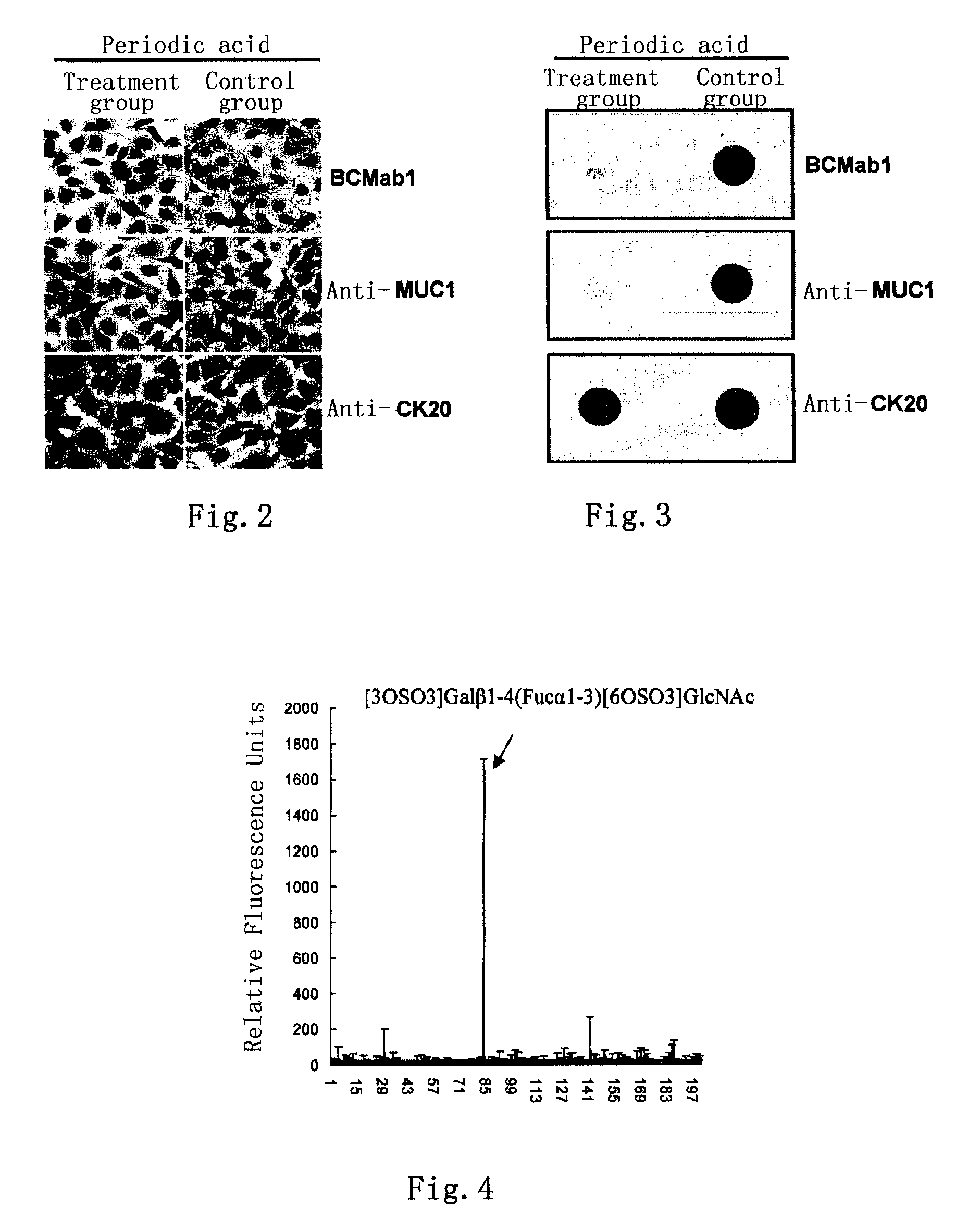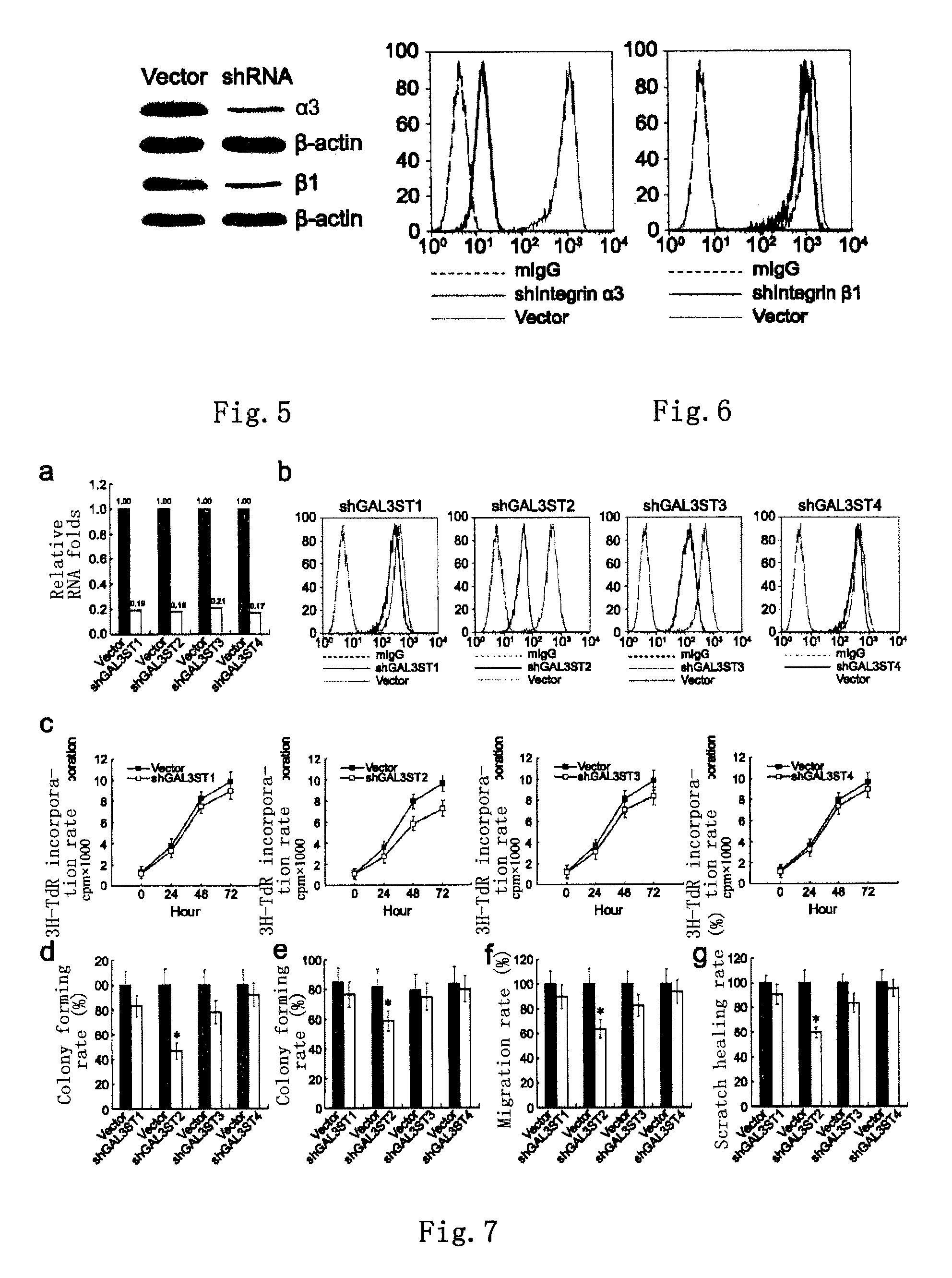Bladder cancer tumor marker, antibody and use thereof
a tumor marker and bladder cancer technology, applied in the field of tumor immunology, can solve the problems of inability to achieve the overall therapeutic effect, inconvenient treatment process, toxic and side effects, etc., and achieve the effect of inhibiting the growth facilitating malignant transformation of bladder cancer, and effectively inhibiting the proliferation of the bladder cancer cell line t24
- Summary
- Abstract
- Description
- Claims
- Application Information
AI Technical Summary
Benefits of technology
Problems solved by technology
Method used
Image
Examples
example 1
Preparation and Purification of BCMab1 Monoclonal Antibody
(1) Preparation of Hybridoma
[0074]Balb / C mice (commercially purchased from Vital River Laboratory Animal Technology Co. Ltd., Beijing) were immunized with human bladder cancer cell line T24 (ATCC: HTB-4) by intraperitoneally injecting a dose of 1×107 cells / ml PBS. After two weeks, the mice were immunized again with the same injection volume and method. While the serum titer of the mice met the requirement, cell fusion was arranged. The mice were boosted three days before the fusion. At the same time, mouse myeloma cells Sp2 / 0 (ATCC CRL-1772) were prepared.
[0075]The sensitized B lymphocytes were fused with the myeloma cells (Practical Immunology, Yang, Y. ed., Changchun Press, published in December, 1994), and selectively cultured (using peritoneal macrophages of the mice as feeder cells) in HAT medium (purchased from Invitrogen Co.; HAT is an enumerate of the initials of hypoxantin, aminopterin and thymidin; HAT medium is thu...
example 2
Identification of Monoclonal Antibody BCMab1
[0080]Normal bladder tissue cells HCV29 were purchased from Peking University Health Science Center. Cell lines T24, EJ, HepG2, LoVo, 293, A375, Jurkat, PC-1, MCF-7, K562, Hela, and other cell lines were purchased from ATCC (Rockville, Md., US). Bladder cancer tissues and normal tissues of human were received from The Second Affiliated Hospital of Kunming Medical University, with informed consents. BALB / C mice and nude mice were both purchased from Chinese Academy of Medical Science Institute of laboratory animal.
[0081]Bladder cancer tissue slices of human (received from Peking University Third Hospital) were stained immunohistochemically with the monoclonal antibody BCMab1 prepared in Example 1 using a conventional method. The result, as shown in FIG. 1, indicated that the bladder cancer tissues of human showed positive reactivity after stained with the monoclonal antibody BCMab1, a secondary antibody (anti-mouse IgG-HRP) and DAB substrat...
example 3
Identification and Preparation of Antigen AG-α3β1
[0084]Human bladder cancer cell line T24 was cultured in a RPMI-1640 medium containing 10% fetal bovine serum (purchased from Invitrogen Co.). After digested with 0.25% pancreatin, 1×108 T24 cells were washed with PBS for 3 times. Then 100 μg monoclonal antibody BCMab1 was added, incubated at 4° C. for 2 hours, and washed with PBS for 3 times. The cells were lysed with 1 ml detergent lysis buffer (50 mM Tris-HCl, pH 8.0; 150 mM NaCl; 0.02% sodium azide; 0.1% SDS; 100 μg / ml PMSF; 1 μg / ml Aprotinin; 1% NP-40; 0.5% sodium deoxycholate) for 30 min, and centrifuged at 12,000 g for 10 min. The supernatant was separated and passed through the Protein G affinity chromatographic column. The column was washed with PBS till its OD value approached zero. Subsequently, elution was carried out using a 0.2 M glycine-HCl solution (pH 2.8), and the eluent was collected. The OD value of each collecting tube was measured, and then the eluent with an OD ...
PUM
| Property | Measurement | Unit |
|---|---|---|
| diameter | aaaaa | aaaaa |
| body weight | aaaaa | aaaaa |
| body weight | aaaaa | aaaaa |
Abstract
Description
Claims
Application Information
 Login to View More
Login to View More - R&D
- Intellectual Property
- Life Sciences
- Materials
- Tech Scout
- Unparalleled Data Quality
- Higher Quality Content
- 60% Fewer Hallucinations
Browse by: Latest US Patents, China's latest patents, Technical Efficacy Thesaurus, Application Domain, Technology Topic, Popular Technical Reports.
© 2025 PatSnap. All rights reserved.Legal|Privacy policy|Modern Slavery Act Transparency Statement|Sitemap|About US| Contact US: help@patsnap.com



